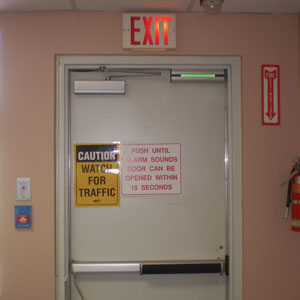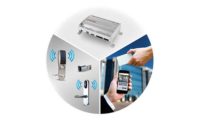
|
|
When installing magnetic locks it is crucial to know not only the code requirements, but also which year’s edition of the code the local jurisdiction follows. PHOTO COURTESY OF RUTHERFORD CONTROLS |
In an industry where technology is king and the latest and greatest in access control can do amazingly sophisticated things, it is somewhat ironic that one of the most complicated and controversial pieces of equipment to install is a lock — a magnetic lock, to be specific. The issues surrounding this relatively simple piece of hardware can get so messy that some dealers and integrators elect to stay away from installing it at all.
What is the big deal? In a word, codes. Building codes. Electric codes. Life safety codes. All of these can play a crucial role in a magnetic lock installation, and they don’t always agree with one another. What’s more, magnetic lock installations have a checkered past that some Authorities Having Jurisdiction (AHJs) are quicker to forget than others.
There has been bad publicity on both sides. The mother of one city council person was locked in an ATM booth overnight because the magnetic lock required two people to operate. (This incident and others like it resulted in codes requiring a motion sensor that would unlock the door and a button within five feet of the door with a timer that would keep the door unlocked for 30 seconds.)
“Because magnetic locks were introduced to doors by non-door people like burglar alarm companies, they sometimes didn’t respect door codes and did some poor jobs,” asserts Mark Berger, president and chief product officer, Securitech, New York, N.Y., and chair of codes and government affairs for the Builders Hardware Manufacturers Association. “And because some of these products were installed so interestingly, you now have some jurisdictions like Indianapolis that will not even allow magnetic locks in the city.”
Misunderstanding of code requirements is at the heart of the historic conflict between AHJs and magnetic lock installers, and continues to cause issues nearly 30 years later.
Prior to 2000, there were three primary code-making bodies, explains Edward Hite, an independent consultant, certified master locksmith and certified fire door inspector who has been heavily involved with codes for the past 25 years. In 2000, they got together to form the International Code Council (ICC), which would develop codes for the newly formed International Building Code. Codes developed prior to that became known as legacy codes.
“Especially during those ‘legacy years’ there were a lot of misconceptions about electromagnetic locks and codes,” Hite says. “People piled a lot of misinformation not only on the expectations of codes, but on the codes themselves.”
For example, the code that covers “access control egress doors” originally assumed that the normal way to release a magnetic lock was with panic bars with switches in them—something that the National Fire Protection Association always supported. But when these legacy codes became part of the International Building Code, the vague language used by the ICC caused a lot of confusion and misinterpretation in the ensuing years.
Going forward the ICC is attempting to make the language more clear and precise to avoid problems, but for now the local jurisdiction, the specific national and state codes and the year in which they were adopted are critical pieces of information to getting it right.
Know the Correct Code
The two national codes that affect magnetic lock installations directly are the International Building Code (IBC) and NFPA 101 Life Safety Code. While the two codes mirror each other, they don’t always agree. Fortunately, the codes aren’t usually used at the same time. So the first step is to determine which code applies to the particular location and building where the mag lock is to be installed.
Whichever code applies, the basic directive for the past decade has been that the motion sensor/switch/timer combination be used and that the door will automatically unlock upon loss of power or activation of the fire alarm or sprinkler system, says Bob Schnarr, technical training instructor, Rutherford Controls Int’l Corp., Cambridge, Ontario, Canada.
Beyond finding out which code applies, it is critical to understand which edition as well, adds Lori Greene, specification team leader, Ingersoll Rand, Carmel, Ind. “The IBC is the most commonly used code, but it depends on which edition because it changes every three years. A town or state can adopt a different edition. In Massachusetts they have adopted the 2009 IBC, but another state could still be on 2003.”
And then, typically, a state also will have a state building code based on that version of the IBC, she adds.
Sometimes which code to follow is less than clear. “The NFPA code is typically used by the government, but a bizarre twist occurs when the federal government owns the land and building the property is on; then they have the authority under GSA to inspect the building under that code,” Hite explains. “But if a government-owned building is on leased land, then it comes under local authority and may be inspected according to IBC.”
Some states require two or more inspections. “There are situations where within a state you could have a building inspector enforcing the building code and the fire marshal using the life safety code,” Greene says. “It is even more complicated in a state like New Hampshire, where state law adopts whatever version of IBC, but then says for matters pertaining to means of egress, use the life safety code. It can get messy.”
Issues & Inconsistencies
Generally, differences between codes are very small and usually can be resolved easily by simply knowing which code applies. The bigger problems occur when the vague language of the code is subject to misinterpretation. As a result there are multiple levels of complexities that can snag an installation when it comes to approval time.
“The biggest issues that arise with installations stem from simply misunderstanding the codes or installers that don’t know the codes,” Schnarr explains.
But misunderstandings happen on the other end as well. “Interpretation of codes is up to the AHJ and many don’t have the education for it, either,” Hite says. “They have the book the size of the old Sears Roebuck catalog, and we have one page in it.”
Lack of education on either side can lead to some confusing situations, and Hite recommends paying close attention specifically to “use and occupancy” requirements. “If you use mag locks with switch hardware, that is specifically allowed in the 2009 IBC code, but only if panic bars are not required,” he says. “If there are 50 or more people in an assembly area, for example, you can’t use switch hardware with the magnetic lock in that version.” The 2012 IBC code changed that to have no restriction, but most states are still working with or just adopting the earlier code. And regardless of code, there are many inspectors who still flat out refuse to accept it, mistakenly believing it is against the code entirely.
Even earlier versions never disallowed switches in hardware (instead of a motion detector, which caused security issues with unlocking the door before knowing what was on the other side), Hite explains. “Versions 2000 to 2006 actually didn’t say you couldn’t use panic bars with switches, but it was written in such a way that people interpreted it that way. The ICC started out trying to include things that were allowed but that proved impossible. So they switched to talking about things they wouldn’t allow. The exclusion of any references in the codes to switches in panic bars was not done with any malice, but rather because switches in bars always met the intent of the code so they felt they didn’t need to address them. Because it was missing in the language, many AHJs interpreted that to mean they weren’t allowed, and the confusion began.”
In fact, the whole sensor/motion detector/button combination was originally designed by the legacy code-making bodies as an alternative to switches for all-glass doors where panic bars couldn’t be used. Misinterpretation caused it to be required for all doors with mag locks. As more states and local jurisdiction adopt the 2009 and later codes, this confusion will get slowly straightened out.
Another situation Greene notes involves the National Electric Code, which is frequently referenced by the IBC and NFPA codes. “A lot of codes and standards become a part of the building code by reference,” she says. “The way the language was worded in the NEC, people were interpreting it to mean that any door that had to unlock upon a fire alarm and had an electric lock on an exterior door would have to unlock completely for both egress and ingress (causing security issues). That was how people were interpreting it, but it wasn’t really the intent. It caused a lot of problems.”
There is also confusion regarding the use of battery backups and bypassing that backup in the event of a fire, while not allowing the situation of a simple power outage to cause an entire building to unlock. “You have to have the right power supply,” Hite says.
Stairwells are another complication. “Stairwells are inherently fire-rated doors, so you can’t use a magnetic lock by itself,” Berger explains. Any fire-rated door has to have positive latching, but also must unlock in a fire situation to allow people to get from one stairwell to another if they encounter smoke or danger.
Securitech has gotten around this by developing a positive latching magnetic lock that meets those requirements. But the local authorities still have to agree to the solution.
“There are definitely situations where local codes are different from what is actually in the national code,” Greene adds. “If code officials perceive that a hazard exists — even if you have followed the code — they can require something different.”
AHJs are god-like when it comes to approving anything and when there are conflicts, the more local authority (or whoever is closest to the building site) wins, Berger adds.
“A magnetic lock is inherently a fail-safe device,” Schnarr says. “It is all a matter of how it is installed that makes it a potential safety hazard. These codes cover how to make these safe, but when it is not installed properly or put in according to very specific codes, that is where problems come in. It is all a matter of understanding how to install it and doing it properly.”
Improving Your AHJ Approval Chances
The absolute best and most recommended way to ultimately get a magnetic lock installation approved is to get the AHJ on board from the beginning, the experts say.
“I always suggest that any installer make the code officials or AHJ their friend,” Schnarr says. “Ask them, ‘what will you accept?’ What code are you going to inspect my door to? The AHJ is not the enemy. If you ask them the right questions and don’t argue over it, they are usually quite reasonable in answering how and what they will accept. Once you get to know them, if they come in and see who did the installation they will have confidence in you, and that goes both ways.”
Berger suggests going even further. “Step one is to make sure the AHJ knows you are his friend and that you don’t want to do anything to violate life safety. The wording of these codes can get questionable, so if it gets complicated, ask the AHJ for an address of an opening that is a good example of the right way to accomplish the goal. Similarly, should you get into a conflicting situation with the AHJ, rather than continuously try to talk about something, instead take him to an opening where you can show something that someone else has approved.”
Approval for an installation varies widely city by city and even inspector by inspector, Hite adds. The safest course of action is always to go to the AHJ locally, familiarize yourself with the code based on the year that jurisdiction is using, then ask for a walk-through of the job site before you do anything. “Ask first, install second,” he advises.
| Special Circumstance #1: Delayed Egress |
|
When discussing magnetic locks, often the issues get confused by a special use of these types of locks in conjunction with a time delay panic bar. Delayed egress systems don’t always incorporate a mag lock, but the two are frequently used in conjunction and when they are, the rules for tying magnetic locks to fire systems change.
Code in the United States specifically covers delayed egress as a separate section, says Bob Schnarr at Rutherford Controls. “These units don’t have to comply the same way as access control egress doors. With delayed egress you can hold someone back from exiting for 15 seconds and, with AHJ approval, for 30 seconds.” Typically used in retail applications for theft deterrence, and in hospitals and mental health facilities for patient protection, delayed egress systems must tie into the fire alarm system and unlock upon activation of the fire system or loss of power. However, there can be confusion and inconsistencies with these systems, as well. Sometimes, the 30-second delay for unlocking the door in delayed egress situations even gets confused by authorities with the 30-second unlock situation required for magnetic locks without delayed egress, causing unnecessary code-compliance issues. Also, NFPA allows a 3-second nuisance delay, but the IBC only allows 1 second, says Mark Berger at Securitech. Just as with the magnetic locks alone, it is key to know the code, the version of the code, and talk to the AHJ beforehand to ensure he will accept a delayed egress system on that door. |
| What About Electric Strikes? |
|
Electric strikes are an option frequently used in place of a magnetic lock where they aren’t accepted by the AHJ or just deemed too much trouble by an installer. While they are often good alternatives, there are some things to be careful of here, as well.
There are definitely high-traffic situations where it is worth seeing if a magnetic lock will be accepted first, says Mark Berger at Securitech. But if electric strikes are the desired hardware, be aware that they are not always code issue-free. “Electric strikes are installed with lever sets and you normally have free egress, so you don’t run into code problems often,” says Bob Schnarr at Rutherford Controls. “But when you get into controlling egress, there are issues. When you use locksets that are keyed with both sides, you should check with your AHJ.” Fire doors are the big exception-to-the-rule for electric strikes, adds Ingersoll Rand’s Lori Greene. “For strikes, if you want to use them in stairwells, there are conflicting requirements if it is a fire-rated door (which virtually all stairwell doors are). These doors need to retain their latch during a fire, but for stairwell re-entry you need a fail-safe product. If you tried to use a fail-safe strike there, the door would not be secure and could potentially open in a fire, so you can’t use electric strikes in that situation.” You also cannot retrofit an electric strike into an existing fire door frame, says consultant Edward Hite. “So many people have done it and it is not correct. Once you cut into a fire rated door frame you have voided the warranty because it is no longer the same product that was fire tested at the laboratory. At that point you almost have to tear out the door frame and redo it.” |




